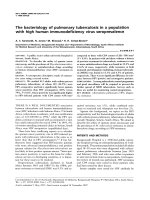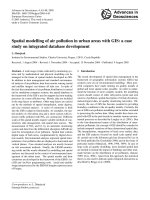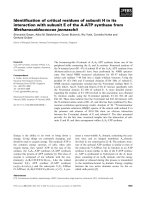Characterisations of EM waves in canonical structures with radomes or coating shell
Bạn đang xem bản rút gọn của tài liệu. Xem và tải ngay bản đầy đủ của tài liệu tại đây (3.96 MB, 171 trang )
Characterisations of EM Waves in
Canonical structures with Radomes or
Coating Shells
Li Zhong-Cheng
A Thesis Submitted
for the Degree of Doctor of Philosophy
Department of electrical and Computer Engineering
National University of Sinapore
2009
Acknowledgments
I would like to take this opportunity to convey my deepest and sincere gratitude to
people without whom I would not have completed this project successfully.
First of all, I wish to extend my heartfelt appreciation to my project main su-
pervisor Prof essor Li Le-Wei and co-supervisor Professor Leong M ook-Seng f o r their
invaluable contributions and guidance throughout the entire course of the project.
Special thanks to my immediate project supervisor Professor Li Le-Wei for his pa-
tient guidance and encouragemen t in times of overcoming difficulties, to which I
am very grateful. I would also l ike to sincerely thank other faculty staff members
from Microwave and RF group: Professor Yeo Tat-Soon and Associate Professor
Ooi Ban-Leong for their help and suggestions.
Secondly, I would like to thank the supporting staff in NUS Microwave and RF
group: Mr. Sing Cheng-Hiong and Mr. Ng Chin Hock. With their kind help and
support, it is thus possible for me to carry out the research and obtain good results
of simulations in this thesis. I n addition, I would like to thank all my friends in NUS
Microwave Research Lab for their invaluable advice and assistance. It is my g reat
pleasure to work with them in the past six years. I am g rateful to Dr. Sun Jin, Mr.
i
ACKNOWLEDGMENTS ii
Wang Yao-Jun, Mr. Pan Shu-Jun, Mr. Chen Yuan, Mr. Lu Lu, Mr. Yao Ji-Jun,
Dr. Gao Yuan, Dr. Ew e Wei-Bin, Dr. Ng Tiong-Hua and Mr. She Hao-Yuan for
being m y most reliable consultants.
Last but not least, I would like to thank my family members who had been a
constan t source of encouragement especially during the most difficult period of the
project. Specifically I would like to thank m y wife, Huang Yan, whose kindness,
patience and support help me get through the hardest time and make my life more
meaningful.
Contents
Acknow ledgments i
Contents iii
Summary viii
List of Figures xi
List of Tables xv
1 Introduction 1
1.1 Background 2
1.2 MotivationfortheProject 8
1.3 ConceptOutline 11
iii
CONTENTS iv
1.4 LayoutoftheThesis 15
1.5 Publications 16
1.5.1 JournalPapers 17
1.5.2 ConferencePresentations 18
2 A 3D Discrete Analysis of Cylindrical Radome Using DGF’s 19
2.1 Introduction 20
2.2 FormulationoftheDiscreteMethod 23
2.2.1 ConceptOutline 23
2.2.2 ApplicationoftheDyadicGreen’sFunctions 24
2.2.3 Unbounded Dya dic Green’s Functions . . . . . . . . . . . . . . 26
2.2.4 ScatteredDyadicGreen’sFunctions 28
2.2.5 CorrectionFactor 29
2.2.6 EquivalentCurrentSource 31
2.2.7 TransmittedField 31
2.3 Applicationto2DEllipticalRadome 32
2.3.1 Implementation 32
CONTENTS v
2.3.2 NumericalResults 34
2.4 Discussion 35
2.5 Conclusions 44
3 Discrete Analysis of a 3D Airbo rne Radome of Superspheroidal Shapes 45
3.1 Introduction 46
3.2 FormulationoftheProblem 47
3.2.1 ConceptOutline 48
3.2.2 Analysisofa3DSuperspheroidalRadome 48
3.2.3 General Formulation of the Electromagnetic Fields . . . . . . 51
3.2.4 Boundary Condition and the Method of Moments . . . . . . . 54
3.3 NumericalResults 56
3.4 Conclusions 59
4 Radiation Due to an Infinitely Transmission Line Near a Dielectric Ellip-
tical Waveguide 60
4.1 Introduction 61
4.2 Coordinate System and Mathematical Functions . . . . . . . . . . . . 63
CONTENTS vi
4.3 DyadicGreen’sFunctions 67
4.4 Equations Satisfied by Scattering Coefficients 71
4.5 FarFieldExpressions 75
4.6 NumericalResults 77
4.7 Conclusions 85
5 Closed-Form Eigenfrequencies in Prolate Spheroidal Conducting Cavi ty 88
5.1 Introduction 89
5.2 Spheroidal Coordinates and Spheroidal Harmonics . . . . . . . . . . . 90
5.3 TheoryandFormulation 92
5.3.1 BackgroundTheory 92
5.3.2 Derivation 93
5.4 NumericalResultsforTEModes 96
5.4.1 NumericalCalculation 96
5.4.2 ResultsandComparison 99
5.5 NumericalResultsforTMModes 102
5.5.1 NumericalCalculation 102
CONTENTS vii
5.5.2 ResultsandComparison 103
5.6 ConclusionandDiscussion 104
6 A New Closed Form Solution to Light Scattering by Spherical Nanoshells
108
6.1 Introduction 109
6.2 BasicFormulas 112
6.3 New Closed Form Solution to Intermediate Coefficients A
n
and B
n
. . 117
6.3.1 Approximate Expression of Co efficient A
n
118
6.3.2 Approximate Expression of Co efficient B
n
120
6.3.3 ValidationsandAccuracy 122
6.4 New Closed Form Solutions to Scattering Coefficients a
n
and b
n
. . . 123
6.4.1 Approximate Expression of Co efficient a
n
123
6.4.2 Approximate Expression of Co efficient b
n
134
6.5 DiscussionsandConclusions 135
7 Conclusions and Future Work 138
Summary
In this thesis, a new discrete method, by making use of cylindrical dyadic Green’s
functions, has been presented in the study of electromagnetic transmission through
a cylindrical radome having arbitrary cross sections. By virtue of using the dyadic
Green’s functions, this method takes into consideration the curvature effect of the
radome’s layer, which is partially ignored in classical approaches such as the ray-
tracing method and the plane wave spectrum analysis. Numerical results are com-
pared with those obtained using the plane wave spectrum method and model cylin-
drical wave-spectrum method.
Also outlined in this thesis is the concept of the Method of Moments(MoM)
applied to study electromagnetic transmission through a superspheroidal radome
with dielectric layer. By means of the inner product, the method effectively takes
into account the continuity of the surface, instead of discretizing it as in the MoM.
This proposed method is thus able to make a more accurate analysis of the electro-
magnetic transmission problem with a superspheroidal radome. Numerical results
on the far field radiation pattern are obtained for various geometrical parameters of
the superspheroidal radome, and also compared.
viii
SUMMARY ix
Next, electromagnetic radiation by an infinitely long transmission line analyzed
using the dyadic Green’s function technique is presented. The transmisison line
is located in the vicinity of an elliptic dielectric waveguide. The dyadic Green’s
functions inside and outside of the elliptic waveguide are formulated first in terms of
the elliptical vector wave functions which are in turn expressed as Mathieu functions.
Using the boundary conditions, we derive d a set of general equations gov erning the
scattering and transmitting c oefficients of the dyadic Green’s functions. From the
integral equations, the scattered and total electric fields in far-zone are then derived
analytically and computed numerically.
An efficient approach is also prop osed to a nalyse the interior b oundary value
problem in a spheroidal cavity with perfectly conducting w all. Then a closed-form
solution has been obtained for the eigenfrequencies based on TE and TM cases. By
means of least squares fitting technique, the values of the coefficients are determined
numerically.
Finally, a n ew set of closed form expressions of the classic Mie scattering co-
efficients of a spherical nanoshell using a power series up to order 6. This set of
approximate expressions is found to be very accurate in the large range of various
potential engineering applications including optical nanoparticle characterizations
and other nanotechnology applications, validated step by step along the derivation
procedure. Computations using this closed form solutions are very fast and accurate
for both lossy and lossless media, and requires v ery little effort in the calculations
of the cross section results. Although examples are limited to nano-scattered appli-
SUMMARY x
cations, the general theory is applicable to a large frequency spectrum ranging from
radio frequency waves to optical waves.
List of Figures
2.1 Illustratingthediscretizationofaradome. 24
2.2 Geometryoftheellipticalradomeusedinthestudy 33
2.3 Radiation pattern for
n
=1 34
2.4 Radiation patterns for various thicknesses at a scan angle of 0
o
36
2.5 Radiation patterns for various thicknesses at a scan angle of 6
o
36
2.6 Radiation patterns for various thicknesses at a scan angle of 18
o
37
2.7 Radiation patterns for various thicknesses at a scan angle of 24
o
37
2.8 Boresight error for a thickness of λ 38
2.9 Peak-gain attenuation for a thickness of λ. 38
2.10 Boresight error for a thickness of 2λ. 39
2.11 Peak-gain atten uation for a thickness of 2λ. 39
xi
LIST OF FIGURES xii
2.12 Radiation pattern for a thickness of λ at a scan angle of 0
o
40
2.13 Radiation pattern for a thickness of λ at a scan angle of 6
o
40
2.14 Radiation pattern for a thickness of λ at a scan angle of 18
o
41
2.15 Radiation pattern for a thickness of λ at a scan angle of 24
o
41
3.1 Geometryoftheellipticalradomeusedinthestudy 49
3.2 Comparison of the MoM result with t he exact result for the radiation
pattern of a dipole array with a spherical dielectric shell. . . . . . . . 57
3.3 Comparison of the MoM result with the AIM result for the radiation
patternofadipolearraywithanogiveradome. 57
3.4 Boresighterrorforvariousthicknessofradome. 58
3.5 Peak-gain attenuations for various thickness of radome. . . . . . . . . 58
4.1 A cross section view of the elliptical coordinate system. . . . . . . . . 63
4.2 Radiation by an infinitely long transmission line in the presence of an
ellipticaldielectriccylinder. 64
4.3 Normalized scattered and total electric fields for u
s
=2a,
r
=2.0
and α =180
o
79
LIST OF FIGURES xiii
4.4 Normalized scattered and total electric fields for u
s
=2a,
r
=2.0+
i2.0andα = 180
o
. 81
4.5 Normalized scattered and total electric fields for u
s
=1.2a,
r
=2.0
and α =180
o
82
4.6 Normalized scattered and total electric fields for u
s
=2b,
r
=2.0
and α =270
o
84
4.7 Normalized scattered and total electric fields for u
s
=1.2b,
r
=2.0
and α =270
o
86
5.1 Prolate spheroidal coordinates (η, ξ, φ) and a conducting cavity. . . . 90
5.2 The values of cξ (vertical axis) satisfying (i) R
(1)
11
(c, ξ) = 0 and (ii) the
fittedequationwithg
0
, g
1
and g
2
determined against ξ (horizontal
axis) 99
5.3 The values of cξ (vertical axis) satisfying (i) ∂/(∂ξ)(R
(1)
11
(c, ξ)
√
ξ
2
− 1) =
0 and (ii) the fitted equation with g
0
, g
1
and g
2
determined against ξ
(horizontalaxis). 104
6.1 Geometry of light scattering by a spherical nanoshell in hosting medium.112
LIST OF FIGURES xiv
6.2 The relative errors of coefficients A
1
, A
2
,andB
1
obtained in this
paper and also in Ref. [59], all compared with the exact solution
obtained using the Mie scattering theory. The bullet-dotted curve
“−−• −−” denotes the results in [59] while the solid curve “––”
standsfortheresultinthischapter 124
6.3 The exact co efficient a
1
versus the spherical core radius x ∈ (0.01, 1.0)
and the spherical nanoshell thickness t ∈ (0.01, 0.4). The other elec-
trical parameters are
1
=(5.44/1.78)
0
,
3
=
0
,and
2
=(
1
+
3
)/2
while μ
1
= μ
2
= μ
3
= μ
0
128
6.4 The relative errors of approximate coefficient a
1
formulas derived here
in this chapter and in the existing work [59] versus the spherical
core radius x ∈ (0.01, 1.0) and the spherical nanoshell thickness t ∈
(0.01, 0.4) 131
6.5 The variation of |a
2
| and the relative errors of the formulas derived
in this chapter and in the existing work [59] versus the spherical
core radius x ∈ (0.01, 1.0) and the spherical nanoshell thickness t ∈
(0.01, 0.4) 133
6.6 The relative errors of th e formulas |b
1
| derived in this chapter and in
the existing work [59] versus the spherical core radius x ∈ (0.01, 1.0)
and the spherical nanoshell thic kness t ∈ (0.01, 0.4) 136
List of Tables
5.1 Expansion Coefficients g
0
, g
1
, g
2
,andg
3
for TE
ns0
Modes (s =1,2,
and3) 100
5.2 Expansion Coefficients g
0
, g
1
, g
2
,andg
3
for TE
ns0
Modes (s =4,5,
and6) 101
5.3 Expansion Coefficients g
0
, g
1
, g
2
,andg
3
for TM
ns0
Mod es (s =1,2,
and3) 105
5.4 Expansion Coefficients g
0
, g
1
, g
2
,andg
3
for TM
ns0
Mod es (s =4,5,
and6) 106
xv
Chapter 1
Introduction
In this thesis, new methods or concepts have been proposed to analyze some specif-
ically s haped canonical objects. One method is proposed to analyze transmission
effects of the electromagnetic field through a cylinder radome whose cross-section
can be non-circular. The other method, which make s use of the spherical dyadic
Green’s functions (DGF’s), is developed to study the electromagnetic transmission
through an axis-symmetric ra dome o f superspheroidal shapes. Next, the elli ptical
dyadic Green’s function technique has been employed to characterize electromag-
netic radiation of an imposed current line sou rce in the presence of a two layered
isotropic dielectric elliptical cylinder. Then, an efficient approach is proposed to
analyse the interior boundary val ue problem in a spheroidal cavit y with perfectly
conducting wall. Finally, a new set of closed form expressions of the classic Mie
scattering coefficients of a spherical nanoshell is derived a power series. To st art
off this introductory c hapter, a brief background on the antenna-radome problem
and on the existing methods that had been used in analyzing such a problem are
1
Chapter 1: Introduction 2
discussed. A fter which the motivation for this project will be highlighted. This is
followed by a brief presentation on the outline of the concepts or methods used in
this project. At the end of this chapter, the organizat ion layout of the remaining
part of the thesis will be given.
1.1 Background
Airborne radar antennas are enclosed in dielectric radomes for protection from a
variety of environmental and aerodynamic effects. The geometry of a irborne rad ome,
being largely determined by aero dynamic considerations, often leads to degradation
of the electromagnetic performance of any enclosed antenna. A good design of
antenna radome system can minimize such undesirable effects. This relies on an
accurate analysis of the effect of a radome on the penetration of electromagnetic
wave. A radome is a dielectric shell that protects the radar antenna while at the
same time tries not to interfere with its operation [1]. Ideally the radome should
appear transparent to radio frequency so as not to degrade the electrical performance
of the enclosed antenna. Unfortunately, due to a dielectric shell that encloses the
antenna, it is inevitable that the wavefront of the electromagnetic wave from the
antenna will be distorted by the radome. T his distortion would cause the radome
to adversely affect the operation of the radar system that it intends to protect.
For example, the radome can produce boresight error, which is an apparent change
in the angular position of a radar source or target. In a modern radar system, a
small boresight error may result in a serious degradation of the ra dar’s performance.
Chapter 1: Introduction 3
In addition, part of the radiation energy is lost as a consequence of the scattering
of electromagnetic wave from the radome surface. This will result in peak-gain
att enuation, which is the loss of peak gain. As a consequence of these tw o effects,
a radome can reduce both the accuracy in determining the angular position of a
target and the range at which the target can be detected. The boresight error and
the peak-gain attenuation are therefore usually the electrical parameters that are of
greatest con cern i n any radome design. These two parameters can b e ob tained by
knowing the characteristic of the electromagnetic field both inside and outside the
radome. A radome can also change the sidelobe level of an antenna.
A precise analysis of radome performance is di fficult, and nearly impossible in
practice [2], because the general shape of a radome layer usually does not fitinto
a frame suitable for an exact analysis. This is especially so for an airborne radome
in which, due to the need for aerodynamic requirements, it’s shapes are not quite
regular. For such a radome, there is no suitable frame that can be used for exact
analysis. To analyze such a radome, one must resort to some approximation meth-
ods. The usual basic principle of appro ximation is to find a canonical configuration
to approximate the surface of the dielectric layer locally, such that from this local
poin t of view, the problem can be solved rigorously by analytic means. The accuracy
of such an approximation depends on how closely the canonical problem resembles
the original one.
In order to analyse accurately and improve the performance of the rad ome,
there are many studies those have been done in this area [3]. One of the tradi-
Chapter 1: Introduction 4
tional techniques is the ray tracing metho d which traces a ray in the direction of
propagation through the radome wall [4—6]. As a widely used method, it prov ides
accurate results for large ra domes, but becomes complicated and less accurate for
rapidly curved shells which may have sharp edges or corners [7]. It makes use of
many approximations, such as treating the radome wa ll at each intercept point as
locally plane, and assuming that the inner and outer radome walls are parallel at
the intercept point. As a result, the method has limited accuracy.
A closely related method is the G eometrical Optics (GO) metho d, which treats
electromagnetic propagation as being “light-like” in behaviour. For large radomes,
the method pro duces a good boresight error prediction accuracy, but it becomes
largely inaccurate for radomes smaller than five wavelengths in diameter. This is
because it makes the assumption that the electromagnetic wave propagates as a
plane wave confined to a cylinder whose cross section the antenna aperture defines.
However this is not true in practice.
A more accurate ray tracing method would be that of the Physical Optics (PO)
tec hnique [8, 9]. This method is based on the Huygen’s principle which states that
each point on a primary wavefront can be considered as a new source of secondary
spherical waves, and that a secondary wavefront can be constructed at the enve-
lope of these spherical waves. Hence the PO method can be employed in surface
integration formulations that produce better accurate results than the GO method.
Beside the various ray tracing techniques, other methods include the plane-
wave sp ectrum [10, 11], modal cylindrical-wave spectrum [12], and the Geometrical
Chapter 1: Introduction 5
theory of diffraction [13] each applying its own approximations to solve the radome
problem. The finite element method was also used, where the radome does not affect
the antenna current distribution, in order for the model to work [14]. For any of
these approaches, the multiple scattering among the source, reflector and radome is
ignored.
The method of moments (MoM) technique [15, 16] is understood to be more
accurate than ray tracing as i t takes into consideration any corners or edges on
the surface of the radomes. This is possible as t he surface of t he radomes are
approximated by numerous planar triangular patches [7, 17]. This approach, due to
the manipulation of large dimensional matrices where electric size of the problem
is large, becomes computationally heavy, hence limiting its application to small
radomes only. Giuseppe and Giorgio [18] proposed an alternative approach to the
MoM technique when they computed the resistance of a dielectric-covered inclined
series slot, but the loss in accuracy is thus encountered. Based on the MoM, the
Conjugate Gradien t - Fast Fourier Transform (CG-FFT) method [19,20] has a much
lower memory requirement and accelerates its computations. This is because the
use of the Fast Fourier Transform results in less operations required, and this in
turn also leads to less errors associated with rounding off during computations.
Electromagnetic scattering of a normal incident plane wave by an elliptical cylin-
der was considered by Yeh [21] and Burke [22]. For the oblique incident case, the
equations needed to s olve for the scattering and transmission coe fficients were for-
mulated by Yeh [23]. The method in those works is to express the incident, scattered
Chapter 1: Introduction 6
and transmitted plane wave s in terms of vector wave eigenfunctions obtained using
the separation of variables method. These eigenfunctions are expressed usually in
terms of Mathieu functions. The continuity boundary conditions were then imple-
mented in determination of the coefficients in the scattered and transmitted waves.
Numerical computations were presented in [21, 22, 24, 25] for the normal incident
plane waves. For the oblique incident plane w aves, numerical computations were
presented by Kim [26]. Up to now, a generalized analysis of electromagnetic radia-
tion problems involving dielectric elliptical cylinders has not been well-documented
yet. This motivates the present work which considers electromagnetic radiation due
to an infinitely transmission line near a dielectric elliptical cylinder.
Calculation of eigenfrequencies in electromagnetic cavities is useful in va rious
applications such as the design o f resonators. H owever, analytical calculation of
these eigenfrequencies is severely limited by the boundary shape of these cavities.
In this thesis, the interior boundary value problem in a prolate spheroidal cavity
with perfectly conducting w all is solved analytically.
Light or electromagnetic scattering by composite spheres is another interest in
the scientific and engineering communities [27—34]. Electromagnetic scattering by
a plasma anisotropic sphere was analyzed [27]. The analysis was extended to Mie
scattering by an uniaxial anisotropic sphere [28]. Furthermore, scattering by an
inhomogeneous plasma anisotropic sphere of multilayers was also fo rmulated and
investigated [29]. It can be easily extended to light scattering by an inhomogeneous
plasma anisotropic sphere where the exact solutions could be applied to obtain the
Chapter 1: Introduction 7
field distributions in the multilayered spherical structures. Along the analysis line
of [27—29], the standard eigenfucntion expansion technique is utilized and the the-
ory for the anisotropic media can still follow closely to theory used for the i sotropic
media. To characterize eigenvalues in the anisotropic media different from those
in the isotropic media, potential formulation and parametric studies for scattering
by rotationally symmetric anisotropic spheres were also carried out recently [30].
In addition, Sun discussed light scattering by coated sphere immersed in absorbing
medium and compared finite-difference time-domain (FDTD) method with analytic
solutions [31]. Scatterers consisting of concentric and nonconcentric m ultilayered
spheres were also considered [32]. An improve d algorithm for electromagnetic scat-
tering of plane wa ve and shaped beams by multilayered spheres was developed [33]
and the geometrical-optics approximation of forward scattering by coated particles
was then discussed [34]. With new developments of nanoscience and nanotechnology,
it becomes desirable to investigate the microcosmic world of the scattering problems.
Nano-scaled objects have thus attracted considerable attentions recently, pri marily
because they have shown some interesting optical properties and are found to be
important for modern photonic applications [ 35—38]. Nano-scaled metallic parti-
cles exhibit interesting optical characteristics and behave differently from those of
normal-scaled dimensions. Interactions of collective and individual particles of met-
als (such as copper, silver and gold) we re studied long time ago [39, 40]. Johnson
andChristyplottedboththerealandimaginary parts of relative permittivities of
copper, silver and gold nanoparticles as a function of photon e nergy in a large range
according to different frequencies [41].
Chapter 1: Introduction 8
1.2 Motivation for the Project
Over the past few decades, the dy adic Green’s function technique has been widely
employed to investigated the interaction of the electromagnetic waves with the lay-
ered media in the boundary-value problem [42, 43]. Dyadic Green’s function is a
very powerful technique for analyzing electromagnetic transmission through dielec-
tric shell [42]. Li et al. [44—46] has derived the general e xpression of the dyadic
Green’s function for multi-layered planar medium, multi-layered spherical medium
and mul ti-la yered cylindrical medium. By using these dyadic Green’s functions,
we are able to obtain a rigorous analysis of the electromagnetic transmission prob-
lem through these media (i.e. planar, spherical and cylindrical). This includes the
m ultiple reflection effects and the curvature effects of the mediums (spherical and
cylindrical) which are taken care of b y these dyadic Green’s functions.
As the dyadic Green’s functions are able to give a ri gorous analysis of the trans-
mission problem by taking curvature into consideration, it is therefore the intentions
of this project to be able to make use of such a property of the dyadic Green’s func-
tion in the analysis of the antenna-radome whose structure can be arbitrary. Unfor-
tunately, for a radome in general, its dyadic Green’s function cannot be obtained.
This is because the shape of the radome will not fit into a suitable frame such that
the derivation of its dyadic Green’s function can be carried out. For the first method,
the existing cylindrical dyadic Green’s functions that had already been derived by Li
et al. will be used in the analysis of a cylindrical radome of arbitrary cross-section.
This will be done “indirectly” through some discretization of the radome surface. In
Chapter 1: Introduction 9
this way, the curvature effect of the radome surface can be accounted for and hence
it will lead to a much better analysis of the an tenna-radome problem as compared to
the methods that uses the plane-slab appro ximation. The outline of this “discrete”
method or concept is discussed in the next section.
As mentioned above, m ost of these methods involve some form of approximations
in the process of solving the antenna-radome problem, like discretizing the surface
into small components for easier analysis. For the second method, the method of
moments is a unifying concept that is often applied to solve complex electromagnetic
problems. Its basic idea is to reduce a functional equation to a matrix equation, and
then to solve the matrix equation by kno wn techniques. These techniques include
point-matching, and approximate operators. The choice of the technique to be u sed
depends largely on the problem set as well as the type of solutions desired. In
the light of the ability of the method of moments to make a continuous instead of
a discrete analysis of the antenna-radome problem, it will be in teresting to make
use of this property in our study of the far field radiation in the presence of a
superspheroidal radome.
To obtain general characteristics of the electromagnetic radiation i n the pres-
ence of dielectric elliptical cylinders, the dyadic Green’s function is an important
ke rnel of the integral equations [47—55]. Also, the dy adic Green’s functions are q uite
important kernels used in numerical techniques such as the Method of Mo ments
and the Boundary Element Method. The free s pace dyadic Green’s function has
already been available in terms of the elliptical vector wave functions. In this work,









